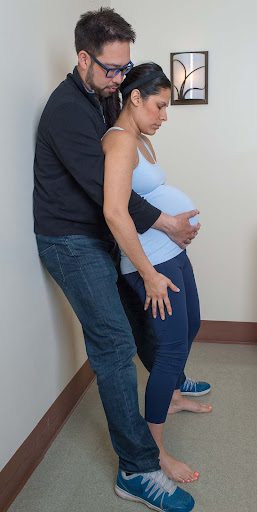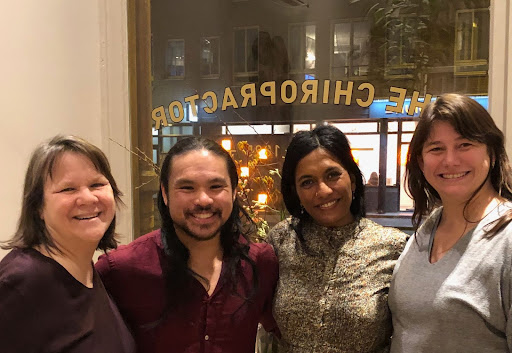February 2022 letter to our community,
As we emerge into a more equitable society, research in birth is also becoming more equitable. Today researchers are questioning past studies of the pelvis, for instance, where the conclusions were biased to white women.
European descendants made up the majority of the political and economic leadership in the formation of the United States. During the industrial era, a profitable medical industry rose and with it, the ability to fund research. Study designs and conclusions too often expressed class and race bias. Such was the bias that determined that the shape of the normal female pelvis was round. Within that biased viewpoint, researchers Moloy and Caldwell set up a classification of pelvic shapes still used today. I’ve redrawn their diagram here, with lines showing the greatest space in the pelvic brim within these pelvic shapes. Continue reading to learn the problem with Moloy’s classifications.

Moloy chose four distinct brim shapes and then, in his aryan-centric view, removed the nuance of the spectrum of shapes existing in the female pelvis of all peoples and assigned each one to a moral value. Typical of the thinking among his associations, but by no means universal.
The shapes of the inlets exist in human bodies. The classification is a human construct, a description only real in the minds of those agreeing with, or fighting against, that view point. In forensic anthropology, identifying race and sex of a skeleton is important and the science in that field verifies there are some minor racial differences. My wish is to dissolve the moral judgement and ranking of the worth of human beings and continue the value of understanding the shapes of the brim for our benefit to assist fetal engagement when necessary.
You’ll see four shapes that do exist among pelvic inlets. The latin names are still in use today.
Oval/”gynecoid” (female). This pelvic brim is open wider side-to-side and is the most round among the shapes. and was said to be present in nearly 50% of Caucasians. The outlet is as wide as the inlet.
Oblong/anthropoid (ape) This pelvic shape is longer front to back. The anterior posterior diameter is greatest. The outlet can be similar to the inlet or has been said to be sometimes slightly narrower but not typically significant in the ability for vaginal birth. The angle of the pelvic inlet can be steeper than the oval or gynecoid and therefore engagement benefits from a posterior tilt in standing positions. It’s possible that this pelvis is also higher top to bottom and therefore we may see more breech and posteriors, and also this pelvis welcomes these positions with the most ease of all brim shapes, especially once baby engages. The oblong shape with a greater front-to-back opening was said to be common in people of African ancestry, also nearly 50%. (This similarity caught my attention in the 1980s when I was first learning obstetric history and I found it very disconcerting to have equal occurrence then divided into such damaging labeling.)
Triangular/android (male) A triangular pelvic brim with a heavier bone mass and narrow outlet. Babies enter the pelvis in LOA position and may not be able to enter the pelvis in other positions unless baby is smaller in proportion to the pelvis. The outlet is smaller than the inlet, like a funnel. Posterior babies are unlikely to rotate once engaged, so helping the OP babies into LOA is quite beneficial. Again, body balancing and birth positions to open the top pelvic anatomy (including round and broad ligaments, psoas and other fascia) may be preventative of stalled labors and shoulder dystocia.
Flat/platepelloid The front-to-back diameter is the most narrow space in this pelvic shape. 5% of pelvises are said to be in this condition which may or may not be hereditary. (Fascia tension during development and time can shape bones.) Baby must engage from the Left Occiput Transverse position (flexed and aligned with the brim). The outlet is quite roomy. Once baby is in the pelvis Engagement can take 40-60 hours without attending to fetal position and 12-24 with full body balancing and an LOT position in first births, 6-12 in subsequent births in my experience. Once the first baby is in the pelvis active labor is often 8 hours. Engagement without body balancing and appropriate birth positions to open the brim will be more painful than transition. With body balancing and matching birth positions to the diameter of the pelvis activates physiology and the obstacles of time and pain are overcome. The potential shoulder dystocia leads many doctors to suggesting cesarean before labor, but upright positioning with open brim positions are preventative. Shoulder dystocia is addressed with rotation of the shoulder to the transverse diameter of the brim, not McRoberts alone.
Objections to Classification
By thinking of pelvic shapes as “types” the mind stays in the idea realm. Humans are known to be non-judgemental and suddenly there arises worth, ranking, preferences and exclusion; not a helpful “hole” to fall down.
- The overpowering objection of pelvic typing is that making one human race the norm makes another race lessor.
- Variety occurs among all human races. (Notice that race itself is a classification.)
- Fetal position, flexion, station, and labor patterns all inform us of any needs for alignment or choosing a better birth position for baby to rotate, engage and descend.
- Racial bias in pregnancy and birth care harms the formation of a person’s life, a family bond, and the health of society. Therefore, inadequacies in birth care inhibit and even harm the quality of human life on earth.
More Recent Study on Pelvic Shapes
Lia Betti of the UK offers a dynamic re-interpretation of pelvic difference in Shaping birth: variation in the birth canal and the importance of inclusive obstetric care. I’ll refer you to Betti’s modern discussion on pelvic typing and the importance of understanding how slight differences may play a role in incorrect technique in forceps and general birth management.
At Spinning Babies®, we seek to offer physiological support for the many, rich variations in all shapes and sizes. Gail Tully, Nicole Morales, Rhea Williams, and other Approved Trainers have called out the limitations of categorizing pelvic shape by race or gender at our workshops. Because our hospital birth education leans toward solving delays in birth without tools or drugs, I considered our recommendations for helping baby into any pelvic brim.
Claudia Booker, a Black Midwife and our advisor in reducing ignorance about Black maternity at Spinning Babies® has passed on to Ancestor status. We had five Spinning Babies® Workshops together and Ms. Booker was planning to join our Approved Trainer services. We sought a better understanding of optimizing pelvic movements and positions with pelvic variations. Claudia compared spontaneous birth movements (and dances) of her Black clients to the birth positions on SpinningBabies.com. We noticed that the angle of our highly recommended posterior pelvic tilt, which is also part of Abdominal Lift and Tuck, serves multiple pelvic inlet shapes.
Baby’s engagement into the pelvis (dropping in) is foremost in avoiding most unnecessary cesareans once contractions have begun. The Abdominal Lift and Tuck helps by making space for baby’s head during each contraction for ten contractions in a row. It doesn’t work without a contraction.
To do the Abdominal Lift and Tuck, the abdomen is lifted with the linked hands of the mother or the hands of the partner who stands behind and reaches supportive arms around to the front of the abdomen. The lift of the belly (originating from Janie King) improves the angle of the baby’s head. Tucking in the tailbone (by doing a posterior pelvic tilt) brings the heavy bone at the top of the sacrum backwards out of baby’s way. By the time ten contractions are done, baby is usually engaged. Labor progresses.
Depending on pelvic shape, this technique may work in one of two ways:
- In a pelvis that has a bit narrow front-to-back diameter like the gynecoid pelvis, the baby’s forehead or shoulder can get caught on the front edge of the inlet. We free baby’s forehead by opening the back of the pelvis with the posterior pelvic tilt (the Tuck portion of Abdominal Lift and Tuck).
- In a pelvis that has a long front-to-back opening at the top, the issue is not that the bone caught the baby’s forehead. Rather the head may be well positioned right over the brim, but because the brim is angled steeply, baby has to enter from the front rather than from above. Tipping the pelvis so the opening is under baby’s head can be so very helpful.
The posterior pelvic tilt portion of the Abdominal Lift and Tuck shifts the pelvic opening so the uterus doesn’t have to do so many contractions to engage the baby.
When baby has yet to engage in labor, lying in bed might lengthen labor. When the openings of the pelvis aren’t suited to being horizontal, eventually the midwife or obstetrician may decide for a cesarean because they don’t know what else to advise. The good news is, even If one doesn’t know for sure about the diameters, doing the Abdominal Lift and Tuck won’t “Undo” the baby’s engagement or slow the birth process. And if the pelvis is optimized by the repositioning of the brim in this way, hours of painful contractions may be avoided.

Try Abdominal Lift and Tuck:
- When labor contractions are regular but labor isn’t picking up
- Labor feels strong like transition but the cervix is not very open
- Baby is staying high even when the cervix is very open
- To help a baby rotate before engagement in the pelvis with a triangular shaped brim
- To help engagement in either head down or breech babies
- Baby doesn’t come down with pushing
Don’t do Abdominal LIft and Tuck:
- When baby is well engaged (-1 or 0 station)
- When baby is seen or felt moving the lower bones of the pelvis apart
- When an epidural or other cause puts the birth giver horizontal (See other options or wait until baby is engaged before starting an epidural, if it’s even needed after this.)
Instructions are on the Abdominal Lift and Tuck page under Techniques on our website.
Let me know what you think!
The following material was part of this original email (now edited)
Gail Tully
Founder of Spinning Babies®Let’s use our bodies to birth our babies!Spinning Babies® Own Essential Team Grows. A recent development is that Jennifer Walker, Approved Trainer, once the Director of the Certified Parent Educator Program, has moved into co-leadership with me. Together our minds make a dynamic whole to grow our team towards our goals to establish physiological birth as normal care. Together with our dedicated staff, Approved Trainers and advanced training instructors, we are bringing forward the gentle, physiological approach for parents and professionals to increase easier birth.
Life work balance deserves attention. Jen Walker and I set time for self care in Amsterdam with walks along the canals to receive care from two practitioners. Gavin Tran from The Chiropractor (a clinic run by Sunita Athisdam). Gavin used a gentle touch to adjust a sticky area which was giving me chronic issues. There was no snap, crackle, pop but rather a sigh and a crinkle. Later, we took turns lying on a warm, crystal filled mat and received acupuncture and a bit of welcome education from Ephrimvael-Paul Downes from Green Alchemy. Here’s a couple of fun photos. When I’m in the US, I often see Chiropractor Susan Quigley from Sunu Wellness in Minnetonka, Minnesota, so it’s fun to include a photo from a Spinning Babies® Workshop which I did with staff from her two clinics (the other is in Minneapolis).


We have a great trio of tools in the shop that midwives and nurses love to use together: The Birth Positions Poster, the Quick Reference Digital Download, and the Spinning Babies® Badge Buddies.
Communicating options for birth positions for comfort and progress has never been easier! Posters are great for antenatal teaching and when showing position during birth, the Quick Reference helps you to have all the details at hand and the Badge Buddy to spark conversation with colleagues and parents alike.
See all upcoming events on our calendar here.

